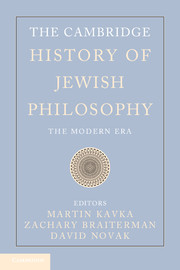Book contents
- Frontmatter
- Contents
- Contributors
- Acknowledgement
- Introduction
- I Judaism's Encounter with Modernity
- II Retrieving Tradition
- 6 Scripture and Text
- 7 Medieval Jewish Philosophers in Modern Jewish Philosophy
- 8 Jewish Enlightenment Beyond Western Europe
- 9 Hasidism, Mitnagdism, and Contemporary American Judaism
- III Modern Jewish Philosophical Theology
- IV Jewish Peoplehood
- V Issues in Modern Jewish Philosophy
- Bibliography
- Index
9 - Hasidism, Mitnagdism, and Contemporary American Judaism
from II - Retrieving Tradition
Published online by Cambridge University Press: 28 September 2012
- Frontmatter
- Contents
- Contributors
- Acknowledgement
- Introduction
- I Judaism's Encounter with Modernity
- II Retrieving Tradition
- 6 Scripture and Text
- 7 Medieval Jewish Philosophers in Modern Jewish Philosophy
- 8 Jewish Enlightenment Beyond Western Europe
- 9 Hasidism, Mitnagdism, and Contemporary American Judaism
- III Modern Jewish Philosophical Theology
- IV Jewish Peoplehood
- V Issues in Modern Jewish Philosophy
- Bibliography
- Index
Summary
It is surely not difficult to see that our time is a time of birth and transition to a new period. Spirit has broken with the world as it has hitherto existed and with the old ways of thinking, and is about to let all this sink into the past; it is at work giving itself a new form.
G.W.F. HegelRabbi Joel Teitelbaum (d. 1980), the Grand Rabbi of Satmar who built the Satmar dynasty in postwar America and Israel, once told his Hasidim in Williamsburg, Brooklyn, “Today there are no longer any mitnagdim [opponents of Hasidism].” One can assume that his disciples understood this to mean that Teitelbaum's magnificent success rebuilding his Hasidic dynasty after the Holocaust meant that Hasidism has finally succeeded in overcoming the mitnagdic polemic against them that began in 1772. But Reb Yoelish, as he was called, was never that predictable. “Why is this so?” he asked, answering his own question, “Because there are no longer any Hasidim!” This was a stinging yet largely accurate appraisal of what may have been the last great schism in Jewish history before the total collapse of any Jewish hegemony after World War II. The destruction of eastern European Jewry meant, among many other things, the demise of any claim of hegemony by traditional Jewish rabbinic authorities. This is surely true in America, perhaps less so in Israel. In any event, Reb Yoelish's point, I think, is that for Hasidism to win, it had to lose. And win it did.
From Reb Yoelish's perspective, the radical edge of the Hasidic revolution in its early years had been softened enough to make Hasidism almost indistinguishable from its Lithuanian antagonists known as the mitnagdim. Or, perhaps, Hasidism succeeded enough to expand the elasticity of the mitnagdic world such that what divided them was no longer foundational enough to sustain the polemic.
- Type
- Chapter
- Information
- The Cambridge History of Jewish PhilosophyThe Modern Era, pp. 280 - 308Publisher: Cambridge University PressPrint publication year: 2012

